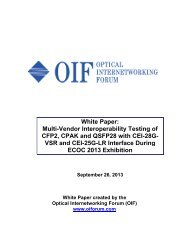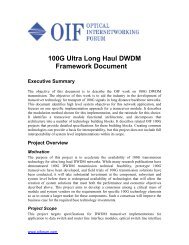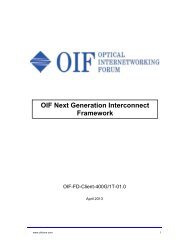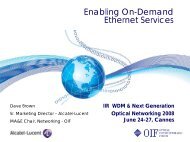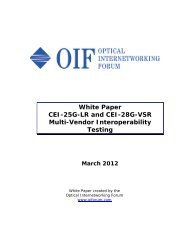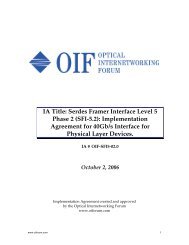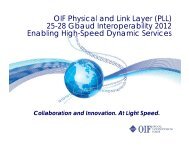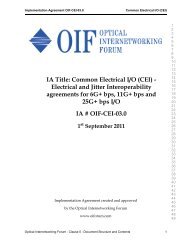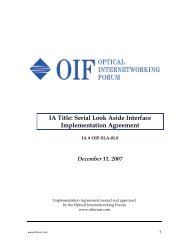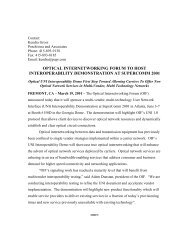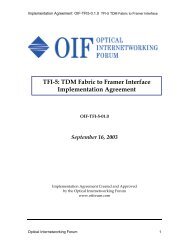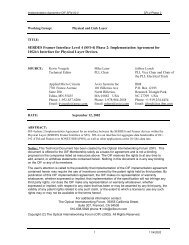External Network-Network Interface (E-NNI) OSPF-based Routing - 1 ...
External Network-Network Interface (E-NNI) OSPF-based Routing - 1 ...
External Network-Network Interface (E-NNI) OSPF-based Routing - 1 ...
Create successful ePaper yourself
Turn your PDF publications into a flip-book with our unique Google optimized e-Paper software.
<strong>External</strong> <strong>Network</strong>-<strong>Network</strong> <strong>Interface</strong>(E-<strong>NNI</strong>) <strong>OSPF</strong>-<strong>based</strong> <strong>Routing</strong> - 1.0(Intra-Carrier) Implementation AgreementOIF-E<strong>NNI</strong>-<strong>OSPF</strong>-01.0January 17, 2007Implementation Agreement created and approvedby the Optical Internetworking Forumwww.oiforum.com
Launched in April of 1998, the OIF is the only industry group uniting representatives fromdata and optical networking disciplines, including many of the world's leading carriers,component manufacturers and system vendors. The OIF promotes the development anddeployment of interoperable networking solutions and services through the creation ofImplementation Agreements (IAs) for optical, interconnect, network processing andcomponent technologies, and optical networking systems. The OIF actively supports andextends the work of national and international standards bodies with the goal of promotingworldwide compatibility of optical internetworking products. Working relationships orformal liaisons have been established with the IEEE 802.3, IETF, ITU-T Study Group 13, ITU-TStudy Group 15, IPv6 Forum, MFA Forum, MEF, MVA, ATIS OPTXS, ATIS TMOC, Rapid I/O,TMF, UXPi and the XFP MSA Group.For additional information contact:The Optical Internetworking Forum, 48377 Fremont Blvd.,Suite 117, Fremont, CA 94538510-492-4040 Φ info@oiforum.comwww.oiforum.comNotice: This Technical Document has been created by the Optical Internetworking Forum (OIF). This document isoffered to the OIF Membership solely as a basis for agreement and is not a binding proposal on the companies listed asresources above. The OIF reserves the rights to at any time to add, amend, or withdraw statements contained herein.Nothing in this document is in any way binding on the OIF or any of its members.The user's attention is called to the possibility that implementation of the OIF implementation agreement contained hereinmay require the use of inventions covered by the patent rights held by third parties. By publication of this OIFimplementation agreement, the OIF makes no representation or warranty whatsoever, whether expressed or implied, thatimplementation of the specification will not infringe any third party rights, nor does the OIF make any representation orwarranty whatsoever, whether expressed or implied, with respect to any claim that has been or may be asserted by anythird party, the validity of any patent rights related to any such claim, or the extent to which a license to use any suchrights may or may not be available or the terms hereof.© 2007 Optical Internetworking ForumThis document and translations of it may be copied and furnished to others, and derivative works that comment on orotherwise explain it or assist in its implementation may be prepared, copied, published and distributed, in whole or inpart, without restriction other than the following, (1) the above copyright notice and this paragraph must be included onall such copies and derivative works, and (2) this document itself may not be modified in any way, such as by removingthe copyright notice or references to the OIF, except as needed for the purpose of developing OIF ImplementationAgreements.By downloading, copying, or using this document in any manner, the user consents to the terms and conditions of thisnotice. Unless the terms and conditions of this notice are breached by the user, the limited permissions granted above areperpetual and will not be revoked by the OIF or its successors or assigns.This document and the information contained herein is provided on an “AS IS” basis and THE OIF DISCLAIMS ALLWARRANTIES, EXPRESS OR IMPLIED, INCLUDING BUT NOT LIMITED TO ANY WARRANTY THAT THE USE OFTHE INFORMATION HEREIN WILL NOT INFRINGE ANY RIGHTS OR ANY IMPLIED WARRANTIES OFMERCHANTABILITY, TITLE OR FITNESS FOR A PARTICULAR PURPOSE.www.oiforum.com 2
Table of Contentswww.oiforum.com 3OIF-E<strong>NNI</strong>-<strong>OSPF</strong>-01.0E-<strong>NNI</strong> <strong>OSPF</strong>-<strong>based</strong> <strong>Routing</strong> 1.01 INTRODUCTION.........................................................................................................................................................................61.1 PROBLEM STATEMENT ...............................................................................................................................................................71.2 SCOPE..........................................................................................................................................................................................71.3 RELATIONSHIP TO OTHER STANDARDS BODIES ......................................................................................................................81.4 MERITS TO OIF ...........................................................................................................................................................................81.5 WORKING GROUPS ....................................................................................................................................................................91.6 DOCUMENT ORGANIZATION ....................................................................................................................................................91.7 KEYWORDS .................................................................................................................................................................................92 TERMINOLOGY AND ABBREVIATIONS ...........................................................................................................................92.1 DEFINITIONS...............................................................................................................................................................................92.2 ABBREVIATIONS .......................................................................................................................................................................113 BASIC COMPONENTS FOR <strong>OSPF</strong>-BASED E-<strong>NNI</strong> ROUTING .....................................................................................123.1 BASIC ASSUMPTIONS ...............................................................................................................................................................123.2 TRANSPORT AND TRAFFIC CONSIDERATIONS FOR ROUTING MESSAGES ............................................................................123.3 CONSIDERATIONS FOR HIERARCHY AND TOPOLOGY ABSTRACTION..................................................................................143.4 SECURITY CONSIDERATIONS FOR ROUTING MESSAGES........................................................................................................144 SUPPORT OF G.7715.1 LINK ATTRIBUTES – LINK IDENTIFICATION....................................................................154.1 LINK IDENTIFICATION WITH FULL SEPARATION OF NODE ID AND RC/SC IDS.................................................................154.2 LOCAL/REMOTE NODE ID FOR PROTOTYPE TESTING..........................................................................................................174.3 STANDARD PROTOCOL EXTENSIONS ......................................................................................................................................175 SUPPORT OF G.7715.1 NODE ATTRIBUTES –REACHABILITY ADVERTISEMENT.............................................175.1 CLIENT REACHABILITY ADVERTISEMENT ...............................................................................................................................175.2 TNA ADDRESS AND NODE ID ADVERTISEMENT FOR PROTOTYPE TESTING.......................................................................185.3 STANDARD PROTOCOL EXTENSIONS ......................................................................................................................................186 SUPPORT OF G.7715.1 LINK ATTRIBUTES – LAYER-SPECIFIC LINK CAPACITY ...............................................186.1 ADVERTISEMENT OF LAYER-SPECIFIC LINK CAPACITY..........................................................................................................186.2 SWITCHING CAPABILITY DESCRIPTOR ENHANCEMENT FOR PROTOTYPE TESTING ............................................................196.3 STANDARD PROTOCOL EXTENSIONS ......................................................................................................................................197 SUPPORT OF G.7715.1 LINK ATTRIBUTES – LOCAL TYPE/ADAPTATIONS SUPPORTED...............................197.1 LOCAL CONNECTION TYPE AND ADAPTATIONS ADVERTISEMENT .....................................................................................197.2 STANDARD PROTOCOL EXTENSIONS ......................................................................................................................................198 SUPPORT OF ROUTING HIERARCHY ...............................................................................................................................198.1 SUPPORT OF MULTI-LEVEL HIERARCHY ..................................................................................................................................198.2 STANDARD PROTOCOL EXTENSIONS ......................................................................................................................................209 E-<strong>NNI</strong> <strong>OSPF</strong>-BASED ROUTING WITH A SINGLE HIERARCHICAL LEVEL ...........................................................209.1 CONFIGURATION......................................................................................................................................................................209.2 OPERATION...............................................................................................................................................................................2310 ARCHITECTURE FOR OPERATION WITH MULTIPLE HIERARCHICAL LEVELS...............................................2310.1 CONFIGURATION ...............................................................................................................................................................2410.2 OPERATION ........................................................................................................................................................................2611 REFERENCES ..............................................................................................................................................................................2712 APPENDIX I: FORMATS OF PROTOCOL ELEMENTS AS USED FOR PROTOTYPE TESTING.........................2812.1 NEW AND EXTENDED SUB-TLVS FOR E-<strong>NNI</strong> <strong>OSPF</strong>-BASED ROUTING..........................................................................2812.2 OPAQUE TE LSAS FOR E-<strong>NNI</strong> <strong>OSPF</strong>-BASED ROUTING..................................................................................................3113 APPENDIX-II SINGLE LEVEL EXAMPLE ...........................................................................................................................3513.1 THE CONTROL DOMAINS ..................................................................................................................................................3613.2 THE CONTROL PLANE .......................................................................................................................................................3713.3 DATA PLANE ......................................................................................................................................................................3713.4 ADVERTISING LINKS FROM RC1 .......................................................................................................................................3813.5 ADVERTISING LINKS FROM RC2 .......................................................................................................................................39
OIF-E<strong>NNI</strong>-<strong>OSPF</strong>-01.0E-<strong>NNI</strong> <strong>OSPF</strong>-<strong>based</strong> <strong>Routing</strong> 1.0developments may result in change to the codepoints and/or formats of theseextensions.The OIF interoperability events included <strong>OSPF</strong> extensions (documented herein) to meetthe following aspects of ASON routing:- Link identification- Client reachability advertisement- Layer-specific link capacity advertisementThe OIF interoperability events did not test <strong>OSPF</strong> extensions for the following aspects ofASON routing:- Local connection type and adaptation advertisement- Multi-level hierarchyIn addition, specific <strong>OSPF</strong> methods were used in these demonstrations to enable routingcontrollers to establish <strong>OSPF</strong> optical network adjacencies even when the routingcontrollers were not topologically adjacent within the SCN.The following areas are NOT encompassed within this document:- Requirements for inter-carrier interfaces are not addressed in this document. Theextensions in this document were defined within the framework of intra-carrier linkstate routing protocol requirements for ASON.- Protocol extensions required to support multi-level hierarchy are not addressed in thisdocument. This document only provides discussion of the target architecture for multilevelhierarchy.1.3 Relationship to Other Standards BodiesThis document, to the maximum extent possible, utilizes standards and specificationsalready available from other organizations. Specifically, the SDH/SONET servicedefinitions are <strong>based</strong> on ITU-T specification [G.707]. The routing protocol requirementsare <strong>based</strong> upon [G.7715] and [G.7715.1], and their normative references to IETF RFCs2328 [<strong>OSPF</strong>] and 3630 [RFC3630]. This version of the specification also documentsprototype extensions, codepoints and formats of these extensions that were tested forinteroperability among prototype implementations. As the intent of OIF is to develop E-<strong>NNI</strong> protocols in close alignment with ITU-T Recommendations, and foundation IETFRFCs, future versions of this specification are intended to align with the IETF and ITU-Tstandard specifications. It is therefore not guaranteed that the future versions of E-<strong>NNI</strong>routing will be fully backward compatible with these prototype extensions. In ananalogous manner, should new routing capabilities be considered in future OIF workefforts, it is expected that the OIF would liaise this information to both ITU-T and IETFbefore being included into future versions of this specification.1.4 Merits to OIFThe E-<strong>NNI</strong> <strong>OSPF</strong> <strong>Routing</strong> 1.0 specification is a key step towards the implementation ofan open inter-domain interface that allows offering dynamic setup and release ofvarious services. This activity supports the overall mission of the OIF.www.oiforum.com 8
1.5 Working GroupsArchitecture & Signaling Working GroupCarrier Working GroupInteroperability Working GroupOAM&P Working GroupOIF-E<strong>NNI</strong>-<strong>OSPF</strong>-01.0E-<strong>NNI</strong> <strong>OSPF</strong>-<strong>based</strong> <strong>Routing</strong> 1.01.6 Document OrganizationThis document is organized as follows:• Section 1: Introduction and Scope of the Document• Section 2: Terminology and Abbreviations• Section 3: Basic <strong>Routing</strong> Components• Sections 4-8: ASON-<strong>based</strong> <strong>Routing</strong> Requirements and Extensions• Section 9: <strong>OSPF</strong>-<strong>based</strong> <strong>Routing</strong> with One Hierarchical Level• Section 10: Architecture for <strong>OSPF</strong>-<strong>based</strong> <strong>Routing</strong> with Multiple HierarchicalLevels• Appendices1.7 KeywordsThe key words “MUST”, “MUST NOT”, “REQUIRED”, “SHALL”, “SHALL NOT”,“SHOULD”, “SHOULD NOT”, “RECOMMENDED”, “MAY”, and “OPTIONAL” in thisdocument are to be interpreted as described in [RFC2119].2 Terminology and Abbreviations2.1 DefinitionsThe following terms are used in this specification.Control DomainThis terminology is adopted from ITU-T [G.8080]. A type oftransport domain where the criterion for membership is the scopeof a control plane component that is responsible for the transportresources within the transport domain.Inter-domain LinkIntra-domain LinkLayerA link with endpoints in two different <strong>Routing</strong> Areas at aparticular level of the routing hierarchy.A link with both endpoints within the same <strong>Routing</strong> Area at aparticular level of the routing hierarchy.This terminology is adopted from ITU-T [G.805]. A layer(network) is a "topological component" that represents thecomplete set of access groups of the same type which may beassociated for the purpose of transferring informationwww.oiforum.com 9
LevelNode IDProtocol ControllerRC IDRC PC IDOIF-E<strong>NNI</strong>-<strong>OSPF</strong>-01.0E-<strong>NNI</strong> <strong>OSPF</strong>-<strong>based</strong> <strong>Routing</strong> 1.0This terminology is adopted from ITU-T [G.8080]. A routinghierarchy describes the relationships between an RA and acontaining RA or contained RAs. RAs at the same depth withinthe routing hierarchy are considered to be at the same routinglevel.This terminology is adopted from ITU-T [G.7715.1]. The Node IDidentifies a node in the transport topology graph. A node mayrepresent both an abstraction of a <strong>Routing</strong> Area or a subnetwork.Note: this definition differs from that given in the OIF UNI 1.0specification.This terminology is adopted from ITU-T [G.8080]. The ProtocolController provides the function of mapping the parameters of theabstract interfaces of the control components into messages thatare carried by a protocol to support interconnection via aninterface.The RC ID is a unique value that identifies an RC instance. Thisidentifier may be used by the database synchronization functionfor record ids.The RC PC ID is a unique value that identifies an RC ProtocolController. As per [G.8080], the Protocol Controller takes theprimitive interface supplied by one or more architecturalcomponents, and multiplexes this interface into a single instanceof a protocolRC PC SCN Address The SCN Address where the RC attaches, via its ProtocolController (PC), to the IP SCN. An RC may have multipleassociated PCs that support the procedures and formats of specificprotocols and attaches to the SCN. The address referred to in thisdocument is for the RC’s <strong>OSPF</strong> PC.<strong>Routing</strong> Area (RA)This terminology is adopted from [G.8080]: A routing area isdefined by a set of subnetworks, the SNPP links that interconnectthem, and the SNPPs representing the ends of the SNPP linksexiting that routing area. A routing area may contain smallerrouting areas interconnected by SNPP links. The limit ofsubdivision results in a routing area that contains a subnetwork.<strong>Routing</strong> Controller (RC) This terminology is adopted from [G.7715]. The <strong>Routing</strong>Controller functional component provides the routing serviceinterface and is responsible for coordination and dissemination ofrouting information.<strong>Routing</strong> Control Domain This terminology is adopted from [G.8080]. A transportdomain is a set of transport resources that are grouped as a resultwww.oiforum.com 10
OIF-E<strong>NNI</strong>-<strong>OSPF</strong>-01.0E-<strong>NNI</strong> <strong>OSPF</strong>-<strong>based</strong> <strong>Routing</strong> 1.0of some criteria that is established by operator policies. An RCD isa type of transport domain where the criterion for membership isassignment to an RC federation for the purposes of transportresource advertisement.Signaling Control<strong>Network</strong> (SCN)TE LinkThe packet network that carries Control Plane messages betweenProtocol ControllersThis definition is per [RFC 4203], which defines a TE link as a“logical" link that has TE properties. The TE link is logical in asense that it represents a way to group/map the informationabout certain physical resources (and their properties) into theinformation that is used by Constrained SPF for the purpose ofpath computation.2.2 AbbreviationsThe following abbreviations are used in this specification.ASONCCCDGMPLSGREE-<strong>NNI</strong>EROIDIETFI-<strong>NNI</strong>ITU-TLSA<strong>NNI</strong><strong>OSPF</strong>PCPCERARCRCDSCNSNSNPPSPFSRLGTETLVTNAAutomatically Switched Optical <strong>Network</strong>sConnection ControllerControl DomainGeneralized Multi-Protocol Label SwitchingGeneric <strong>Routing</strong> Encapsulation<strong>External</strong> <strong>Network</strong>-<strong>Network</strong> <strong>Interface</strong>Explicit Route ObjectIdentifierInternet Engineering Task ForceInternal <strong>Network</strong>- <strong>Network</strong> <strong>Interface</strong>International Telecommunications Union - TelecommunicationsLink State Advertisement<strong>Network</strong>-<strong>Network</strong> interfaceOpen Shortest Path FirstProtocol ControllerPath Computation Element<strong>Routing</strong> Area<strong>Routing</strong> Controller<strong>Routing</strong> Control DomainSignaling Communications <strong>Network</strong>SubnetworkSubnetwork Point PoolShortest Path FirstShared Risk Link GroupTraffic EngineeringType/Length/ValueTransport <strong>Network</strong> Assigned Addresswww.oiforum.com 11
TTLUNIUNI-CUNI-NVLANTime To LiveUser-network interfaceClient side of a UNI<strong>Network</strong> side of a UNIVirtual Local Area <strong>Network</strong>OIF-E<strong>NNI</strong>-<strong>OSPF</strong>-01.0E-<strong>NNI</strong> <strong>OSPF</strong>-<strong>based</strong> <strong>Routing</strong> 1.03 Basic Components for <strong>OSPF</strong>-<strong>based</strong> E-<strong>NNI</strong> <strong>Routing</strong>This routing specification is <strong>based</strong> on [RFC3630] but with a hierarchical operationalmodel per [G.7715] for ASON networks as defined per G.8080. This specification utilizesthe base <strong>OSPF</strong> protocol as defined in [RFC 2328], in [RFC3630] and in [RFC 4203],although some additional requirements for optical transport networks are defined in thefollowing Sections.It should be noted that this specification does not include the use of <strong>OSPF</strong> for themaintenance of SCN topology, and as a result does not include the use of <strong>OSPF</strong> types 1-4LSAs, path computation for IP routing or area border routers.3.1 Basic AssumptionsThis specification conforms to the routing architecture as specified for ASON in[G.7715], It assumes that the network can be organized into a hierarchy of <strong>Routing</strong>Areas, as defined in [G.7715].This specification implements the routing elements defined in ITU-T Recommendation[G.7715.1] for Link State <strong>Routing</strong> Protocols, using <strong>OSPF</strong> as the basis. It makes use ofwork done in IETF on TE extensions to [RFC3630] and GMPLS extensions to <strong>OSPF</strong>[RFC4203] but identifies additional requirements and potential extensions as needed forASON.The hierarchical organization of <strong>Routing</strong> Areas used in this specification (as per[G.8080]) is orthogonal to the <strong>OSPF</strong> multi-area operation defined for IP networks in[RFC 2328]. Applicability of future GMPLS multi-area operations is for further study.The purpose of this routing specification is to re-use <strong>OSPF</strong>-TE in networks witharchitecture as defined by G.8080, but is not aimed at providing IP layer datagramrouting. In addition it assumes that an IP <strong>based</strong> control communications network orSCN, compliant with [G.7712], is in place to support communications between thevarious control entities.3.2 Transport and Traffic Considerations for <strong>Routing</strong> MessagesIt should be noted that sending of extraneous or invalid routing information, e.g., zerolengthadvertisements, should be prevented in order to reduce the overall traffic andprocessing load due to the routing protocol. Extraneous or invalid routing informationSHOULD NOT be recorded in the routing database, and SHOULD NOT cause failure ofthe routing controller.www.oiforum.com 12
OIF-E<strong>NNI</strong>-<strong>OSPF</strong>-01.0E-<strong>NNI</strong> <strong>OSPF</strong>-<strong>based</strong> <strong>Routing</strong> 1.0Unlike traditional IP networks where <strong>OSPF</strong> routers that are usually physically interconnectedto create adjacencies, the RCs that would like to form adjacencies in thisspecification are most likely not topologically adjacent within the control plane, and notalways one IP-hop away in the SCN topology.A number of methods are available to create one-hop adjacencies between <strong>OSPF</strong>instances in nodes that are not topologically adjacent, including a variety of tunnelingmethods (esp. GRE, IP-in-IP and IPSec), use of VLANs at layer 2, and use of <strong>OSPF</strong>virtual links. A number of associated impacts or limitations have been identified:VLANs can only be applied within SCNs consisting of a single ethernet broadcastdomain; virtual links are an optional capability and currently are restricted to being partof an <strong>OSPF</strong> backbone area, which is a different topology than assumed for the E-<strong>NNI</strong>.The point-to-multipoint method defined below was used in all OIF E-<strong>NNI</strong>interoperability testing. Tunneling as described below is an alternative method;selection of a particular tunneling type is for further study.3.2.1 Point-to-Multipoint MethodThe following configuration of <strong>OSPF</strong> point-to-multipoint mode was used for all OIF E-<strong>NNI</strong> interoperability testing. As in <strong>OSPF</strong> point-to-multipoint, all adjacencies betweenRCs are configured, and the <strong>OSPF</strong> Hello is not used for discovery purposes. <strong>OSPF</strong>adjacencies are allowed to be created between RCs more than one hop apart by allowingthe IP TTL to be greater than 1 (as is done for <strong>OSPF</strong> virtual links).It should be noted that the <strong>OSPF</strong> instance used for the E-<strong>NNI</strong> is providing Optical<strong>Network</strong> routing and not IP layer routing for the SCN. As a result, the same <strong>OSPF</strong>adjacency type used for the E-<strong>NNI</strong> is independent of the actual interfaces used toconnect to the SCN.For point-to-multipoint adjacencies to operate across a multi-hop IP SCN, the IP TTLfield for Optical E-<strong>NNI</strong> <strong>Routing</strong> <strong>OSPF</strong> PDUs MUST be set to a value greater than 1 andSHOULD be set to a value of 255. Further, the <strong>Network</strong> mask included in <strong>OSPF</strong> HelloPDUs MUST be set to 0x00000000 to allow adjacencies with nodes that are notimmediate neighbors. Note: this configuration deviates from the typical configurationof <strong>OSPF</strong> for IP routing.3.2.2 Tunneling MethodTunneling is a commonly used technique between non-adjacent nodes, howevertunneling introduces direct SCN links between non-adjacent RCs that could potentiallybe used for any application traffic, if the creation of the tunnel generates an entry in thenode’s IP forwarding table. In this case, in order to avoid unintended traffic routing andpotential traffic looping, additional management is required to ensure that the tunnelsare used only for E-<strong>NNI</strong> messages. Tunneling requires establishing appropriate tunnelsbetween RCs, and then turning these tunnels into interfaces for Optical E-<strong>NNI</strong> related<strong>OSPF</strong>-TE instances only.www.oiforum.com 13
OIF-E<strong>NNI</strong>-<strong>OSPF</strong>-01.0E-<strong>NNI</strong> <strong>OSPF</strong>-<strong>based</strong> <strong>Routing</strong> 1.03.3 Considerations for Hierarchy and Topology AbstractionHierarchical routing can be used to enable the network to scale, and to provide isolationbetween different network domains. Topology abstraction can be used to reduce theamount of information carried by the inter-domain routing protocol. When hierarchy iscreated and topology abstraction is used, the externally advertised topology can be atransformed view of the actual internal topology of a contained <strong>Routing</strong> Area. Thistransformed view is intended specifically to provide information for computation ofpaths crossing the <strong>Routing</strong> Area, represented by advertisements of links and associatedcosts. This can impact routing performance, depending on the conditions within the<strong>Routing</strong> Area and the use of tools that provide additional routing information, e.g., aPath Computation Element as discussed below. If the available bandwidth in a domainis large compared to the average service request, node level abstraction will also havelittle negative impact on computed path quality.Advertisement of an abstracted topology of a multi-node domain MUST support a validrepresentation of connectivity within that domain in order to support correct pathcomputation, i.e., if multiple border nodes are advertised for a domain, some topologicalcomponent MUST also be advertised to indicate when there is connectivity betweenthese border nodes. This will avoid failure of path computation across the domain. Ingeneral, path computation should not have to infer from the control identifiers in use(such as the RC identifier) the data plane topology.Work is ongoing in standards to define a capability to query an outside entity todetermine the cost of a path or the optimal path through a particular domain, and thiswould potentially allow path computation across the domain with more preciseinformation than is advertised externally using the E-<strong>NNI</strong> routing protocol. Thisfunctional entity is known as a Path Computation Element. A PCE can be supported ina number of ways, including via the management plane.3.4 Security Considerations for <strong>Routing</strong> MessagesSecurity considerations for link state routing protocols are covered in Section 9 of theAddendum to the Security Extension for UNI and <strong>NNI</strong> [SecAdd], which updates theSecurity Extension [SecExt]. Section 9.1 of the Addendum [SecAdd] recommends howimplementations not using the Security Extension MAY provide authentication of <strong>OSPF</strong>messages. Section 9.2 of the Addendum describes how implementations using theSecurity Extension to protect signaling protocols MUST extend these mechanisms to<strong>OSPF</strong> routing.www.oiforum.com 14
OIF-E<strong>NNI</strong>-<strong>OSPF</strong>-01.0E-<strong>NNI</strong> <strong>OSPF</strong>-<strong>based</strong> <strong>Routing</strong> 1.04 Support of G.7715.1 Link Attributes – LinkIdentification4.1 Link Identification with full separation of Node ID and RC/SC IDsASON has defined a number of different functional entities, each with their ownidentifier spaces. The identifier spaces used by ASON <strong>Routing</strong> are described in theSection 7.1 of [G.7715.1]:There are three categories of identifiers used for ASON routing: transport plane names,control plane identifiers for components, and SCN addresses.• Transport plane names describe [G.805] resources and are defined inG.8080/Y.1304.• SNPP names give a routing context to SNPs and are used by the controlplane to identify transport plane resources. However, they do notidentify control plane components but represent a (G.805) recursivesubnetwork context for SNPs. Multiple SNPP name spaces may exist forthe same resources.• UNI Transport Resource names are used to identify transport resources at aUNI reference point if they exist. They represent clients in(G.8080/Y.1304) access group containers and may be disseminated byRCs.• Control plane identifiers for G.8080/Y.1304 components may be instantiateddifferently from each other for a given ASON network. For example, one canhave centralized routing with distributed signalling. Separate identifiers arethus used for:• <strong>Routing</strong> Controllers (RCs)• Connection Controllers (CCs)• Additionally, components have Protocol Controllers (PCs) that are used forprotocol specific communication. These also have identifiers that areseparate from the (abstract) components like RCs.• SCN addresses enable control plane components to communicate with eachother via the SCN as described in [G.7712].Using these definitions, Table 1 reviews the different identifiers used in [RFC3630], andsuggests a logical mapping to ASON identifiers. Note: IETF has also defined alexicography comparing GMPLS and ASON terminology [RFC4397], for generalmapping of terminology.www.oiforum.com 15
OIF-E<strong>NNI</strong>-<strong>OSPF</strong>-01.0E-<strong>NNI</strong> <strong>OSPF</strong>-<strong>based</strong> <strong>Routing</strong> 1.0Instance in <strong>OSPF</strong>-TE[RFC3630]Source and DestinationIP Addresses.Router AddressRouter ID in <strong>OSPF</strong> PDUHeaderAdvertising Router ID.Link ID.DescriptionTable 1: Identifier TableThis is the address used bythe RC PCs to communicatewith each other. It is alsoknown as the RC PC IPaddress. Located in the IPpacket header of the packetcontaining <strong>OSPF</strong> PDUs.Traffic EngineeringTopLevel TLV from[RFC3630]. This iscontained in an Opaque type10 LSA.Used to identify theneighbor that generated thePDU containing LSAs.Field contained in an LSAHeader. For a given PDU,this is likely to be differentfrom the Router ID in the<strong>OSPF</strong> Header. For a TELink TopLevel TLV, thisfield identifies the router atthe near end of a link.SubTLV contained in a TELink TopLevel TLV. For agiven PDU, this is likely tobe different from the RouterID in the <strong>OSPF</strong> Header. Fora TE Link TopLevel TLV,this identifies the router at<strong>OSPF</strong>-TE AddressSpaceIPv4 Address space.IPv4 Address.([RFC3630] statesthat this is a“reachable” IPv4address.)Router ID.Router ID. (seeNote)Router ID. (seeNote)G.8080 ArchitecturalNameRC PC SCN Address.Linked to TransportPlane Node ID as wellas RC and SC PC SCNaddressControl Plane Name:RC PC IDLinked to both RC IDand Transport PlaneNode IDLinked to both RC IDand Transport PlaneNode IDthe far end of a link.Note: RFC 2328 [<strong>OSPF</strong>] defines the SPF algorithm used to traverse the topology sharedby <strong>OSPF</strong> nodes in an area. This algorithm specifically uses Router ID as the Vertex IDwhen identifying a point-to-point link between two routers in the topology, as shown inSection 16.1 of [<strong>OSPF</strong>]. This is further underscored in Section 16.1 Step 2 and Step 2bwhere Router-LSAs for vertex V (the near end of a link) and vertex W (the far end of alink) are retrieved using the Vertex ID. Since the Router IDs for the near end of a TE linkand the far end of a TE link in [RFC3630] are located in the Advertising Router ID andthe Link ID fields for the Link TLV (see [RFC 3630] Sect 2.4.2 and 2.5.2), these fields areused in [RFC3630] to identify the link ends that exist in the TE topology.By using different categories of identifiers for Transport plane entities, Control planeentities and SCN addresses, it is possible in ASON to support a number of differentfunction distributions including:- 1:N relationship between an RC and Subnetworks- N:1 relationship between RCs and a Subnetworkwww.oiforum.com 16
OIF-E<strong>NNI</strong>-<strong>OSPF</strong>-01.0E-<strong>NNI</strong> <strong>OSPF</strong>-<strong>based</strong> <strong>Routing</strong> 1.0This allows a separation between the transport plane entity being controlled, the controlplane entity supporting it, and the SCN address where the control plane entity can bereached.Support for these distributions is considered useful for domain-to-domain networkingand allows flexibility for support of E-<strong>NNI</strong> routing by domains with differentcharacteristics. It helps support domains with differing characteristics and abstraction ofdomain topology and resource information as called for in OIF carrier requirements[CarReq].4.2 Local/Remote Node ID for Prototype TestingTo support 1:N or N:1 relationships as described above for unnumbered links, thecapability is needed to uniquely identify unnumbered links when advertising. Themethod used in prototype testing was to advertise the Transport Plane Node ID for localand remote link ends, separately from the RC associated with the link. SubTLV formatsand codepoints to advertise the Node IDs associated with link ends were introduced forOIF prototype testing and are given in Appendix I.Note: Since the Node ID extensions provide the Transport Plane Name for a LocalVertex and Remote Vertex on a link in the Transport Topology, the Advertising RouterID and Link ID fields are no longer used to identify the nodes at the ends of a link,reducing the role of the Advertising Router ID field to a part of the Database key used toname LSAs.Futhermore, since the Node ID comes from the Transport Plane namespace, it is used asthe identifier in an Explicit Route Object, removing the dependence on the RouterAddress TLV.4.3 Standard Protocol ExtensionsFor further study pending completion of associated standards in IETF and ITU-T. Initialwork evaluating ASON requirements against existing routing protocol can be found in[Eval], and potential solutions being discussed in IETF can be found in [Soln].5 Support of G.7715.1 Node Attributes –ReachabilityAdvertisement5.1 Client reachability advertisementIn IP routing, it is expected that the way to calculate a route to an endpoint is for theendpoint to be announced in the routing protocol. However, end equipment in IPv4networks is typically attached using Ethernet subnetworks advertised via <strong>Network</strong>LSAsor <strong>External</strong>LSAs. This makes separate end equipment advertisement unnecessary.Unfortunately, the optical network environment discussed in this document is outsidethe IPv4 network and does not have an analogous method for a router to advertise theUNI endpoints associated with a vertex in the area’s topology. Consequently, acapability to advertise client reachability is needed, as is identified in [G.7715.1].www.oiforum.com 17
OIF-E<strong>NNI</strong>-<strong>OSPF</strong>-01.0E-<strong>NNI</strong> <strong>OSPF</strong>-<strong>based</strong> <strong>Routing</strong> 1.0[RFC 3496]) to represent contiguous concatenation, i.e. STS-(3xN)c SPE / VC-4-Nc, N =4, 16, 64, 256.As [G.7715.1] specifies link capacity as a link characteristic specific to a particular layernetwork, a representation in the form of tuples of is most closely consistent with ASON requirements and provides accurateand separable information on a fine grained, per layer network basis.6.2 Switching Capability Descriptor enhancement for Prototype TestingTo provide this functionality, a new format for Switching Capability Descriptor wasused in prototype testing that incorporates information about available connections atspecific signal types. This allows more accurate accounting of resource availability, inparticular taking into account impact of time slot allocation on the availability ofconnections using contiguous concatenation.The format for the Switching Capability Descriptor used in OIF prototyping is given inAppendix I.6.3 Standard Protocol ExtensionsFor further study pending completion of associated standards in IETF and ITU-T. Initialwork evaluating ASON requirements against existing routing protocol can be found in[Eval], and potential solutions being discussed in IETF can be found in [Soln].7 Support of G.7715.1 Link Attributes – LocalType/Adaptations Supported7.1 Local Connection Type and Adaptations advertisement[G.7715.1] identifies the need to advertise Local Adaptation support associated with alink in the link state routing protocol. This requirement applies to the E-<strong>NNI</strong> routinginterface.No OIF interop testing has been done for protocol extensions advertising localtype/adaptations supported.7.2 Standard Protocol ExtensionsFor further study pending completion of associated standards in IETF and ITU-T. Initialwork evaluating ASON requirements against existing routing protocol can be found in[Eval], and potential solutions being discussed in IETF can be found in [Soln].8 Support of <strong>Routing</strong> Hierarchy8.1 Support of multi-level hierarchy[G.7715] and [G.7715.1] specify that routing protocol for ASON supports multiple levelsof hierarchy, although they do not define specific mechanisms to support multiplewww.oiforum.com 19
OIF-E<strong>NNI</strong>-<strong>OSPF</strong>-01.0E-<strong>NNI</strong> <strong>OSPF</strong>-<strong>based</strong> <strong>Routing</strong> 1.0<strong>OSPF</strong> Area A1Topology at theFirstHierarchicalS1BN3S2S3<strong>Routing</strong>ControllersBN1BN6BN8CD1BN4BN2BN5BN7CD2<strong>Routing</strong> Control DomainsCD3Base LevelFigure 2. Example of Single Level <strong>OSPF</strong>-TE Operation.9.1.1 <strong>Routing</strong> ControllersEach routing control domain includes at least one routing controller. A routingcontroller is identified by its RC ID.In the example of Figure 2, S2 is a federation of multiple RCs that advertises routinginformation for CD2 within Area A1.9.1.2 <strong>Routing</strong> Controllers in Adjacent <strong>Routing</strong> Control Domains (per RC)For each routing controller advertising for a given routing control domain, there exists atleast one peer RC advertising for each adjacent control domain, and for each RC, thefollowing information MUST be available:1) The <strong>Routing</strong> Controller ID of the neighboring <strong>Routing</strong> Controller.2) The SCN address of the neighboring <strong>Routing</strong> Controller.Example - Information about adjacent control domains that is provisioned in S2 asfollows:Table-2 Adjacent <strong>Routing</strong> Controllers of S2 in Figure 2Neighboring RCs RC ID SCN AddressS1 S1’s Router ID S1’s SCN addressS3 S3’s Router ID S3’s SCN address9.1.3 Inter-domain Links (per RC)Information on inter-domain links can be configured on a RC. An inter-domain linkreflects an inter-connection with an adjacent domain along with the traffic parameters inthe outgoing direction, i.e., from the local node to the remote (adjacent) node.Example - There are a total of 4 inter-domain links in the perspective of CD2 that areprovisioned on S2 as follows:www.oiforum.com 21
OIF-E<strong>NNI</strong>-<strong>OSPF</strong>-01.0E-<strong>NNI</strong> <strong>OSPF</strong>-<strong>based</strong> <strong>Routing</strong> 1.0Table-3 Inter-domain Links Configured on RC S2 in Figure 2Inter-domainlinksLocalbordernodeRemotebordernodeBN3-BN1 BN3 BN1BN4-BN2 BN4 BN2BN5-BN7 BN5 BN7BN6-BN8 BN6 BN89.1.4 Intra-Domain Links (per RC)One or more intra-domain links can be configured on an RC if it advertises an intradomaintopology, or may be derived by the RC from internal domain routinginformation. An intra-domain link reflects some characteristics of traversing the domain,as reflected by advertised link traffic parameters on one direction, i.e. from the ingressnode to the egress node.In the example of Figure 2, 12 intra-domain links are advertised by S2 to reflectcharacteristics of traversing CD2 from one border node to another as follows:Table-4 Intra-domain links Configured on RC S2 in Figure 2Intra-domain Local border node Remote borderlinksnodeBN3-BN4 BN3 BN4BN4-BN3 BN4 BN3BN3-BN5 BN3 BN5BN5-BN3 BN5 BN3BN3-BN6 BN3 BN6BN6-BN3 BN6 BN3BN4-BN5 BN4 BN5BN5-BN4 BN5 BN4BN4-BN6 BN4 BN6BN6-BN4 BN6 BN4BN5-BN6 BN5 BN6BN6-BN5 BN6 BN5Note the intra-domain links are abstract in nature, reflecting the aggregation of thetopology in the RC. Also the number of intra-domain links that need to be provisioned isa local matter.9.1.5 The reachable TNA addresses (per RC)The TNA addresses that are attached to NEs in a given RA are advertised by the RC inthe RA at the next hierarchical level. These can be summarized before the advertising forscaling purposes.Example - TNA addresses that are reachable within the CD2 and need to be advertisedby S2 are provisioned on S2 or derived from internal routing information.www.oiforum.com 22
OIF-E<strong>NNI</strong>-<strong>OSPF</strong>-01.0E-<strong>NNI</strong> <strong>OSPF</strong>-<strong>based</strong> <strong>Routing</strong> 1.09.2 OperationThe purpose of the configuration as described in the section above is to start the firsthierarchical level of an <strong>OSPF</strong>-TE <strong>based</strong> routing control domain. Each RC that has beenconfigured starts to run as an <strong>OSPF</strong>-TE node at the first hierarchical level by exchanging<strong>OSPF</strong>-TE messages with the neighboring RCs. No routing adjacencies are createddirectly between neighboring border nodes unless they are also serving as RCs for theirrespective domains.The RCs in the first hierarchical level will form routing adjacencies in the control plane,and at the same time, each RC will advertise the links that correspond to the interdomainand intra-domain links for its associated domain. Also, each RC will advertisethe reachable TNA addresses for that domain.In the example as illustrated in Figure 2, RCs S1, S2 and S3 will form regular <strong>OSPF</strong>routing adjacencies in the control plane [Note: the detailed implementation of S2 as afederation of routing controllers is beyond the scope of this document]. At the sametime, S2 will advertise the abstract links that correspond to Table-3 as part of thetopology of the first hierarchical level area (<strong>OSPF</strong> area A1 in the Figure). The links thatcorrespond to Table-3 specify the link attributes from CD2 to CD1 and from CD2 toCD3, and the corresponding link attributes from CD1 to CD2 and from CD3 to CD2 willbe advertised by S1 and S3, respectively. The links that correspond to Table-4 exposerouting information associated with CD2, and are useful during the routing pathselections for connections that traverse CD2, i.e., which entry border node to use foringress, and which exit border node to use for egress. In addition, S2 will advertiseCD2’s reachable TNA addresses throughout <strong>OSPF</strong> area A1.Operation of the routing protocol (e.g., Database Synchronization and Link StateAdvertisement Flooding) otherwise follows procedures defined in RFC 2328 [<strong>OSPF</strong>] andin Section 3. Timers for generating link advertisements must be configurable by theoperator to avoid mismatch at sending and receiving nodes.10 Architecture for Operation with Multiple HierarchicalLevelsThe routing hierarchy as proposed by this document is achieved by stacking separaterouting areas vertically. The requirements defined in this section are intended to beconsistent with requirements for hierarchical routing defined in [G.7715.1], Section 8. Ina given routing area, there is a single routing protocol that runs independently, andthere is at least one RC, selected either via provisioning or election, which representsthat RA at the next higher level in the routing hierarchy. There usually exist somecommunication mechanisms between the RC at hierarchical level N and routing entitieswithin the control domain it represents in order to exchange routing information in bothdirections, i.e., routing information feed-up and feed-down, however this is internal tothe domain.www.oiforum.com 23
10.1 ConfigurationOIF-E<strong>NNI</strong>-<strong>OSPF</strong>-01.0E-<strong>NNI</strong> <strong>OSPF</strong>-<strong>based</strong> <strong>Routing</strong> 1.0Some configuration is required to build up the routing hierarchy. An operator decidesthe hierarchical structure of the routing areas, that is, the containment hierarchy ofrouting areas, which is usually a reflection of the hierarchical organization of theoperator’s network.Level N+1Area A4 (CD11)BN19BN20S8Level NS9S10Area A3 (CD8)Area A1 (CD9)Area A2 (CD10)S1S2S3Level N-1BN12BN18BN11BN17CD6 CD7BN3BN6BN1BN4CD2 BN5BN2BN7CD1BN8CD3BN15BN16BN10BN9BN13 BN14 CD4CD5Figure 3. An Example of a Multi-level Hierarchy.For example in Figure 3, the network is arranged into 2 levels of routing hierarchy. Inlevel N of the hierarchy there are three distinct routing areas: A1, A2, and A3. Norouting messages are exchanged by routing controllers within these areas and routingcontrollers within these areas only can find routes across their respective areas. All threeof these routing areas are hierarchically contained in a fourth routing area whichoperates up a level in the hierarchy. In area A4 the RCs are advertising routinginformation for routing control domains encompassing the areas A1, A2 and A3(respectively S8, S9, and S10).10.1.1 <strong>Routing</strong> Controllers and <strong>Routing</strong> AreasFor a <strong>Routing</strong> Area RA n that is at hierarchical level N, there is at least one <strong>Routing</strong>Controller RC n+1 at hierarchical level N+1, up to the highest level of the hierarchy.With the hierarchical routing model as proposed by this document, the operation at eachlevel of hierarchy that is associated with the single <strong>Routing</strong> Area is independent.However, the routing information obtained as a result of executing link state routing at agiven hierarchy level can feed up (except at the highest hierarchical level) and feeddown (except at the lowest hierarchical level), or alternatively be configured on the<strong>Routing</strong> Controller for that level.The reason for information feed-up is so that the routing information that is associatedwith one <strong>Routing</strong> Area can be advertised to others and can be used for routing decisionsfor the setup of connections that cross optical control domains. The feed-up of routingwww.oiforum.com 24
OIF-E<strong>NNI</strong>-<strong>OSPF</strong>-01.0E-<strong>NNI</strong> <strong>OSPF</strong>-<strong>based</strong> <strong>Routing</strong> 1.0information is performed level-by-level on a given node. It is desirable that the feed-upis accomplished together with aggregation and summarization for scaling purposes. Therouting information fed up from level N is advertised by the <strong>Routing</strong> Controller RC n+1 atthe Level N+1 with the advertiser identified as RC n+1 . Therefore there is no need for the<strong>Routing</strong> Controllers at higher levels of the hierarchy to learn about the identifiers(<strong>Routing</strong> Controller ID, <strong>Routing</strong> Area ID, etc.) at lower levels. Another reason for theinformation feed-up is to reduce the configuration burden, i.e., some componentsespecially in the data plane can be automatically aggregated by RCs at lower level.The reason for information feed-down is so that the routing information associated withother <strong>Routing</strong> Areas is available in the “local” <strong>Routing</strong> Area and the routing forconnections across or to the remote <strong>Routing</strong> Areas can be calculated by nodes in the“local” <strong>Routing</strong> Area in a distributed fashion. The information provided from the LSAsare that originated by RCs in <strong>Routing</strong> Areas at higher-levels are actually extensions inboth control plane and data plane to <strong>Routing</strong> Areas beyond the local one, withaggregation and summarization, and the information can be directly used in thecall/connection routing procedure.Note the feed-down of routing information is optional; see the following sections fordetails.10.1.2 <strong>Routing</strong> Controllers in Adjacent RCDs (per RC)The provisioning of information concerning RCs in adjacent domains is exactly the sameas described in the Section 9.1.2.Example – In Figure 3, suppose S9 is a federation of RCs representing Area A1, and S10and S8 are RCs for areas A3 and A2, respectively. The Router ID and SCN address of S8and S10 are configured on S9, and the Router IDs and SCN addresses of S9 areconfigured on S8 and S10, respectively, as well.10.1.3 Inter-Domain links (per RC)The configuration for inter-domain links may be different from that described in Section9.1.3 due to additional aggregation of the border nodes and inter-domain links at higherlevels of the routing hierarchy.Example - When interconnecting the control domains CD9 and CD10 where there existtwo physical links BN13-BN14 and BN15-BN16, the border nodes and links areaggregated at the higher level so that the following configuration is applied to S9 andS10:Table-5 Inter-Domain Links Configured on S9 in Figure-3Inter-domainlinksLocalbordernodeRemotebordernodeBN19-BN20 BN19 BN20www.oiforum.com 25
10.2 OperationTable-6 Inter-Domain Links Configured on S10 in Figure-3Inter-domainlinksLocalbordernodeRemotebordernodeBN20-BN19 BN20 BN19OIF-E<strong>NNI</strong>-<strong>OSPF</strong>-01.0E-<strong>NNI</strong> <strong>OSPF</strong>-<strong>based</strong> <strong>Routing</strong> 1.010.2.1 Adjacency in the Control PlaneGiven a routing area RA N at hierarchical level N, there is a correspondent routingcontroller RC N+1 in RA N+1 at hierarchical level N+1. In the Figure 3, the domains CD9,CD10 and CD8 are represented by RCs S8, S9 and S10, respectively in area A4(corresponding to CD11), and form routing adjacencies for exchange of <strong>OSPF</strong> routinginformation for area A4.10.2.2 Topology Aggregation and Feed-Up for AdvertisingTopology of the control domain from Level 1 up can be aggregated by RCs andadvertised at the next level of hierarchy automatically, or through configuration. Note:alternatives to topology aggregation may be defined in future versions of this document.10.2.2.1 Inter-Domain LinksAs described in Section 9.1.2, information on the inter-domain links can be configuredon the routing controllers at the level of the routing hierarchy containing both linkendpoints.10.2.2.2 Intra-Domain LinksIntra-domain links can be configured as described in Section 9.1.4 in a hierarchicalrouting network with multi-level hierarchies, but they can also be discovered andoriginated automatically. When there are at least 2 border nodes advertised externallyfor a routing area, the intra-domain topology can be aggregated by computing virtualintra-domain links. The intra-domain links, once aggregated, can be advertised by theRCs that belong to the control domain in the next higher level of hierarchy.10.2.3 TNA Address Summarization and Feed-Up for AdvertisingIn a routing area that is at the hierarchical level N (N >=1), each node in that area canadvertise one or more TNA addresses throughout that area. The RC in that area canperform summarization on all these reachable TNA addresses, before advertising TNAreachability at the next higher level of hierarchy.10.2.4 <strong>Routing</strong> Information Feed Down from Level N to N-1<strong>Routing</strong> information that is recorded at the nodes at hierarchical level N (N >= 2) can befed down to the nodes at level N-1 with a standardized mechanism such as is describedbelow. Note: alternatives to feed down that reduce the information storagerequirements for lower level RCs may be defined in future versions of this document.www.oiforum.com 26
OIF-E<strong>NNI</strong>-<strong>OSPF</strong>-01.0E-<strong>NNI</strong> <strong>OSPF</strong>-<strong>based</strong> <strong>Routing</strong> 1.0The feed-down of the routing information can be performed by the RC at Level N bypassing the routing information down to an associated RC or RCs at Level N-1, whichthen in turn advertise the routing information throughout the routing area where the RCbelongs.The routing information that can be fed down includes the following:1) LSA that contains inter-domain links.2) LSA that contains intra-domain links.3) LSA that contains reachable TNA addresses.The LSAs at Level N that have been fed down may be advertised by the RC at Level N-1as is. The same information can also be further fed down to Level N-2, etc., in the samemanner.The purpose of the routing information feed-down is to distribute the traffic engineeringinformation across the control domains to all nodes at the lower hierarchy levels,possibly also to all nodes at Level 0, so that the path selection for end-to-end connectionscan be accomplished in distributed manner.11 ReferencesITU-T[G.707] ITU-T Recommendation G.707/Y.1322 (2003), “<strong>Network</strong> Node <strong>Interface</strong> for theSynchronous Digital Hierarchy (SDH)”,[G.7715] ITU-T Recommendation G.7715/Y.1706 (2002), “Architecture andRequirements for <strong>Routing</strong> in the Automatically Switched Optical <strong>Network</strong>”[G.7715.1] ITU-T Recommendation G.7715.1/Y.1706.1 (2004), “ASON <strong>Routing</strong>Architecture and Requirements for Link State Protocols”[G.7712] ITU-T Recommendation G.7712/Y.1703 (2003), “Architecture and Specificationof Data Communication <strong>Network</strong> ”,[G.805] ITU-T Recommendation G.805 (2000), “Generic Functional Architecture ofTransport <strong>Network</strong>s”[G.8080] ITU-T Recommendation G.8080/Y.1304 (2003), “Architecture of the AutomaticSwitched Optical <strong>Network</strong> (ASON)”OIF[CarReq] oif2002.229.05, Inter-domain Control Plane Prioritized Requirements[SecAdd] Optical Internetworking Forum Implementation Agreement, “Addendum tothe Security Extension for UNI and <strong>NNI</strong>,” OIF-SEP-02.1, March 2006.[SecExt] Optical Internetworking Forum Implementation Agreement, “SecurityExtension for UNI and <strong>NNI</strong>,” OIF-SEP-01.1, May 2003.IETFwww.oiforum.com 27
OIF-E<strong>NNI</strong>-<strong>OSPF</strong>-01.0E-<strong>NNI</strong> <strong>OSPF</strong>-<strong>based</strong> <strong>Routing</strong> 1.0[RFC2119] IETF RFC 2119, “Key Words for Use in RFCs to Indicate RequirementLevels”, March 1997.[RFC3630] IETF RFC 3630, “Traffic Engineering Extensions to <strong>OSPF</strong> Version 2”,September. 2003[RFC3946] IETF RFC 3946, “Generalized Multiprotocol Label Switching Extensions forSONET/SDH Control”, October 2004.[RFC4202] IETF RFC 4202, “<strong>Routing</strong> Extensions in Support of Generalized Multi-Protocol Label Switching”, October 2005.[RFC4203] IETF RFC 4203, “<strong>OSPF</strong> Extensions in Support of Generalized MPLS”, October2005.[RFC4397] IETF RFC 4397, “A Lexicography for the Interpretation of GMPLSTerminology within the Context of ITU-T ASON Architecture”, February 2006.[Eval] Hopps, et al, “Evaluation of Existing <strong>Routing</strong> Protocols Against ASON <strong>Routing</strong>Requirements”, draft-ietf-ccamp-gmpls-ason-routing-eval-03.txt, May 2006, approvedfor RFC – RFC Editor Queue (to be updated with RFC number when available).[<strong>OSPF</strong>] IETF RFC 2328, “<strong>OSPF</strong> version 2”, April 1998.[Soln] Papadimitriou, “<strong>OSPF</strong>v2 <strong>Routing</strong> Protocol Extensions for ASON <strong>Routing</strong>”, draftietf-ccamp-gmpls-ason-routing-ospf-01.txt,Work in Progress, August 2006.12 Appendix I: Formats of Protocol Elements As Used forPrototype Testing12.1 New and Extended Sub-TLVs for E-<strong>NNI</strong> <strong>OSPF</strong>-<strong>based</strong> <strong>Routing</strong>The prototype extensions defined in this appendix allow for full separation of differentcontrol identifiers as required for ASON. However, this does not imply that differentvalues are always used for each identifier. An implementation MAY use duplicatevalues (in mandatory fields) when full separation is not required; it MUST howeveraccept TLVs from peer implementations that do support full separation.12.1.1 Local Node ID Sub-TLVThe Local Node ID sub-TLV (Type 32773 ) is included in an inter-domain or intradomainTE link LSA to indicate the local end point of a link. This is used to supportseparation of the control and data planes, as well as topology abstraction. The format ofthis sub-TLV is defined as:0 1 2 30 1 2 3 4 5 6 7 8 9 0 1 2 3 4 5 6 7 8 9 0 1 2 3 4 5 6 7 8 9 0 1+-+-+-+-+-+-+-+-+-+-+-+-+-+-+-+-+-+-+-+-+-+-+-+-+-+-+-+-+-+-+-+-+| Type (32773) | Length |+-+-+-+-+-+-+-+-+-+-+-+-+-+-+-+-+-+-+-+-+-+-+-+-+-+-+-+-+-+-+-+-+| Local Node ID |+-+-+-+-+-+-+-+-+-+-+-+-+-+-+-+-+-+-+-+-+-+-+-+-+-+-+-+-+-+-+-+-+12.1.2 Remote Node ID Sub-TLVThe Remote Node ID sub-TLV (Type 32774) is included in an inter-domain or intradomainTE link LSA to indicate the remote end point of a link. This is used to supportwww.oiforum.com 28
OIF-E<strong>NNI</strong>-<strong>OSPF</strong>-01.0E-<strong>NNI</strong> <strong>OSPF</strong>-<strong>based</strong> <strong>Routing</strong> 1.0separation of the control and data planes, as well as topology abstraction. The format ofthis sub-TLV is defined as:0 1 2 30 1 2 3 4 5 6 7 8 9 0 1 2 3 4 5 6 7 8 9 0 1 2 3 4 5 6 7 8 9 0 1+-+-+-+-+-+-+-+-+-+-+-+-+-+-+-+-+-+-+-+-+-+-+-+-+-+-+-+-+-+-+-+-+| Type (32774) | Length |+-+-+-+-+-+-+-+-+-+-+-+-+-+-+-+-+-+-+-+-+-+-+-+-+-+-+-+-+-+-+-+-+| Remote Node ID |+-+-+-+-+-+-+-+-+-+-+-+-+-+-+-+-+-+-+-+-+-+-+-+-+-+-+-+-+-+-+-+-+12.1.3 Sonet/SDH <strong>Interface</strong> Switching Capability Descriptor sub-TLVThis sub-TLV (Type 32775 and Length (4 + n x 4) octets) is dedicated to Sonet/SDHbandwidth accounting, and has the following format:0 1 2 3 4 5 6 7 8 9 0 1 2 3 4 5 6 7 8 9 0 1 2 3 4 5 6 7 8 9 0 1+-+-+-+-+-+-+-+-+-+-+-+-+-+-+-+-+-+-+-+-+-+-+-+-+-+-+-+-+-+-+-+-+| Type (32775) | Length = 4 + n*4 |+-+-+-+-+-+-+-+-+-+-+-+-+-+-+-+-+-+-+-+-+-+-+-+-+-+-+-+-+-+-+-+-+| Switching Cap | Encoding | Reserved |+-+-+-+-+-+-+-+-+-+-+-+-+-+-+-+-+-+-+-+-+-+-+-+-+-+-+-+-+-+-+-+-+| Signal Type | Number of Unallocated Timeslots |+-+-+-+-+-+-+-+-+-+-+-+-+-+-+-+-+-+-+-+-+-+-+-+-+-+-+-+-+-+-+-+-+| Signal Type | Number of Unallocated Timeslots |+-+-+-+-+-+-+-+-+-+-+-+-+-+-+-+-+-+-+-+-+-+-+-+-+-+-+-+-+-+-+-+-+| |// . . . //| |+-+-+-+-+-+-+-+-+-+-+-+-+-+-+-+-+-+-+-+-+-+-+-+-+-+-+-+-+-+-+-+-+| Signal Type | Number of Unallocated Timeslots |+-+-+-+-+-+-+-+-+-+-+-+-+-+-+-+-+-+-+-+-+-+-+-+-+-+-+-+-+-+-+-+-+Note: n defines the number of signal types supported on this link, and thus defined asgreater or equal to 1.Inherited from [RFC 4203], the Switching Capability field and the Encoding field MUSTtake the following values for Sonet/SDH interfaces:Switching Capability (8 bits): value 100 (TDM).Encoding (8 bits): value 5 for Sonet/SDH.Reserved (16 bits): set to zero when sent and ignored when received.Signal Type (8 bits): inherited from [RFC 3946], the Signal Type field(s) MUST take oneof the following values:Value Type Comment1 VT1.5 SPE / VC-11 Unused2 VT2 SPE / VC-12 Unused3 VT3 SPE Unused4 VT6 SPE / VC-2 Unused5 STS-1 SPE / VC-36 STS-3c SPE / VC-421 STS-12c SPE/VC-4-4c New value22 STS-48c SPE/VC-4-16c New value23 STS-192c SPE/VC-4-64c New valuewww.oiforum.com 29
OIF-E<strong>NNI</strong>-<strong>OSPF</strong>-01.0E-<strong>NNI</strong> <strong>OSPF</strong>-<strong>based</strong> <strong>Routing</strong> 1.0Number of Unallocated Timeslots (24 bits):Specifies the number of identical unallocated timeslots per Signal Type and per Link. Assuch, the initial value(s) of this TLV indicates the total capacity in terms of number oftimeslots per link. The signal type included in the BW announcement is specific to thelayer link being reported and is not derived from some other signal type (e.g. STS-48c isnot announced as 16 x STS-3c)For instance on an OC-192/STM-64 interface either the number of STS-3c SPE/VC-4unallocated timeslots is initially equal to 64, or the number of STS-48c SPE/VC-4-16cunallocated timeslots is equal to 4 or even a combination of both type of signalsdepending on the interface capabilities. Once one of these components gets allocated fora given connection, the number of unallocated timeslots is decreased by the number oftimeslots this connection impliesThe number of available timeslots per link is calculated independently for each signaltype as resource utilization on the link changes. For example, an OC-192/STM-64interface with one STS-1 timeslot in use would be advertised with the followingunallocated timeslots (assuming that the link is able to support a full range of STS-192cand lower rate signals):sts192c 0sts48c 3sts12c 15sts3c 63sts1 191(0*sts192c
OIF-E<strong>NNI</strong>-<strong>OSPF</strong>-01.0E-<strong>NNI</strong> <strong>OSPF</strong>-<strong>based</strong> <strong>Routing</strong> 1.00 1 2 30 1 2 3 4 5 6 7 8 9 0 1 2 3 4 5 6 7 8 9 0 1 2 3 4 5 6 7 8 9 0 1+-+-+-+-+-+-+-+-+-+-+-+-+-+-+-+-+-+-+-+-+-+-+-+-+-+-+-+-+-+-+-+-+| type (32776) | Length (variable) |+-+-+-+-+-+-+-+-+-+-+-+-+-+-+-+-+-+-+-+-+-+-+-+-+-+-+-+-+-+-+-+-+| Addr length | Reserved |+-+-+-+-+-+-+-+-+-+-+-+-+-+-+-+-+-+-+-+-+-+-+-+-+-+-+-+-+-+-+-+-+| One TNA |+-+-+-+-+-+-+-+-+-+-+-+-+-+-+-+-+-+-+-+-+-+-+-+-+-+-+-+-+-+-+-+-+Other defined type values are:1) IPv6 TNA – 327782) NSAP TNA – 32779The addr_length specifies the length of the TNA address specified in number of bits.Address prefixes can be used to aggregate TNA addresses. The addr_length is used torepresent TNA address prefixes. For example, the address prefix 192.10.3.0/24 can beadvertised with a TNA of 193.10.3 with an addr_length = 24.12.1.5 Node_ID Sub-TLVThe Node ID sub-TLV (Type 32777) is included in the TNA Address TLV and containsthe node hosting this TNA address(es). The format of this optional sub-TLV is definedas:0 1 2 30 1 2 3 4 5 6 7 8 9 0 1 2 3 4 5 6 7 8 9 0 1 2 3 4 5 6 7 8 9 0 1+-+-+-+-+-+-+-+-+-+-+-+-+-+-+-+-+-+-+-+-+-+-+-+-+-+-+-+-+-+-+-+-+| Type (32777) | Length |+-+-+-+-+-+-+-+-+-+-+-+-+-+-+-+-+-+-+-+-+-+-+-+-+-+-+-+-+-+-+-+-+| Node ID |+-+-+-+-+-+-+-+-+-+-+-+-+-+-+-+-+-+-+-+-+-+-+-+-+-+-+-+-+-+-+-+-+12.2 Opaque TE LSAs for E-<strong>NNI</strong> <strong>OSPF</strong>-<strong>based</strong> <strong>Routing</strong>12.2.1 Overview[RFC 4203] defines two types of top-level TLVs, i.e., the node level TLV and the linklevel TLV. This specification adds an address TLV as the third type of top-level TLV. Thepurpose of the address TLV, or TNA address TLV is to advertise the TNA in a given<strong>Routing</strong> Area.www.oiforum.com 31
www.oiforum.com 32OIF-E<strong>NNI</strong>-<strong>OSPF</strong>-01.0E-<strong>NNI</strong> <strong>OSPF</strong>-<strong>based</strong> <strong>Routing</strong> 1.0Type Top Level TLV Semantics Reference Scope1 Router Address TLV No standard <strong>OSPF</strong>-TE Originated from anysemantics defined [RFC3630] RC participating infor prototypethe RA. Mandatorytestingfor consistency with[RFC 3630]2 (TE) Link TLV Point-to-point link <strong>OSPF</strong>-TE[RFC3630]Originated from anyRC advertising one(or more) TE Link .Mandatory for <strong>NNI</strong>routing.3 Reachable TNAAddress TLVReachable TNA’s Section 5 Originated from anyRC advertising TNAReachability . Carrierdependent (see notebelow).Table A1-1: Opaque TE LSAsAdvertisement of the Router Address TLV and (TE) Link TLV is mandatory for <strong>NNI</strong>routing. Advertisement of TNA Address TLVs is dependent on the carrier network.However, if received these MUST be stored and flooded to neighboring RCs.Note: as per [RFC 3630], the Router Address TLV appears in exactly one TrafficEngineering LSA originated by a RC. Only one Link TLV SHALL be carried in eachTraffic Engineering LSA originated by a RC. In addition, only one Reachable TNAAddress TLV SHALL be carried in each Traffic Engineering LSA originated by a RC.12.2.2 <strong>Routing</strong> Controller Opaque LSAA <strong>Routing</strong> Controller (RC) represents a routing control domain. [G.7715.1] describes theset of information that has to be included in the mandatory <strong>Routing</strong> Controller OpaqueLSA where the top-level TLV is the Router Address TLV format defined in [RFC 4203].No.TLV Semantics Reference Optional/Mandatory1 Router IP Address top Top level TLV [RFC3630] MandatoryTLVTable A1-2: <strong>Routing</strong> Controller Information12.2.3 TE link Opaque LSAThe TE link opaque LSA is used to represent an inter-domain link or an intra-domainlink. The <strong>Routing</strong> Controller field in the <strong>OSPF</strong> packet header carries the advertising RCID for both cases, whereas the Link ID sub-TLV carries the peer RC ID for inter-/intradomainlinks or the peer RC ID for inter-domain links and the unknown value for intradomainlinks. The latter occurs when an abstracting RC ID originates TE link opaqueLSAs representing intra-domain links.A TE link LSA contains the following information:
OIF-E<strong>NNI</strong>-<strong>OSPF</strong>-01.0E-<strong>NNI</strong> <strong>OSPF</strong>-<strong>based</strong> <strong>Routing</strong> 1.0No.TLV Semantics Reference Mandatory/Optional1 Link top TLV Top level TLV [RFC3630] M (mandatory)2 Link type sub-TLV Point-to-point link [RFC3630] M3 Link ID sub-TLV Peer’s Router ID (RC-ID) [RFC3630] MNote: For inter-domainlinks this value MUST beset to the peering RC-ID.For intra-domain links indomains with a singlerouting controller thisvalue is considered as“unknown” (and MUST beset to 0.0.0.0). For intradomainlinks in domainswith multiple routingcontrollers this value is setto a peering <strong>Routing</strong>Controller ID (RC-ID).4 Link metric sub- Link cost [RFC3630] M (by defaultTLVequal to 1)5 Link resource class Color [RFC3630] M (by defaultsub-TLVbit mask equalto 0…0)6 Local Identifier in Local interface ID [RFC 4203] MtheLinklocal/remoteidentifier sub-TLV7 Remote Identifier in Remote interface ID [RFC 4203] M (if unknowntheLinkSHOULD be setlocal/remoteto 0.0.0.0)identifier sub-TLV8 Link protectiontype sub-TLVwww.oiforum.com 33Link protection type [RFC 4203] O (by defaultunprotectedlinks)9 SRLG sub-TLV Shared risk link group [RFC 4203] O (by defaultLink ID is theSRLG)10 Local node ID sub-TLVLocal endpoint(E.g., border node ID)See Section11.1.1M11 Remote node IDsub-TLV12 SONET/SDH<strong>Interface</strong> SwitchingCapabilityRemote endpoint(E.g., remote border nodeID)Describe the TE linkbandwidth information inthe form that suitable inSee Section11.1.2See Section11.1.3MM
Descriptor TLVoptical networks.NOTE – the exact format ofbandwidth encoding isdescribed in Section 5.2.2.3Table-A1-3 Inter-domain and Intra-domain Link informationOIF-E<strong>NNI</strong>-<strong>OSPF</strong>-01.0E-<strong>NNI</strong> <strong>OSPF</strong>-<strong>based</strong> <strong>Routing</strong> 1.0Note 1: per [RFC3630], Link Type and Link_ID sub-TLV’s MUST appear exactly once.Remote Node ID, Link metric and <strong>Interface</strong> ID sub-TLVs defined above MAY occur atmost once.Note 2: setting of the Link ID to 0.0.0.0 as described in the table above deviates from theuse of the Link ID as defined in [RFC3630].The Local Identifier (#6 in the table above) and the Remote Identifier (#7 in the tableabove) are both part of the Link Local/Remote Identifiers sub-TLV (Type 11) defined in[RFC4203]. The format of this sub-TLV is defined as:0 1 2 30 1 2 3 4 5 6 7 8 9 0 1 2 3 4 5 6 7 8 9 0 1 2 3 4 5 6 7 8 9 0 1+-+-+-+-+-+-+-+-+-+-+-+-+-+-+-+-+-+-+-+-+-+-+-+-+-+-+-+-+-+-+-+-+| Link Local Identifier |+-+-+-+-+-+-+-+-+-+-+-+-+-+-+-+-+-+-+-+-+-+-+-+-+-+-+-+-+-+-+-+-+| Link Remote Identifier |+-+-+-+-+-+-+-+-+-+-+-+-+-+-+-+-+-+-+-+-+-+-+-+-+-+-+-+-+-+-+-+-+Note 1: under certain conditions the Link Remote Identifier MAY be coded "0" where theIdentifier value is not known. When this is true, the link advertisement is not includedin path calculation.Note 2: under certain conditions the Link ID and Remote Node ID can containredundant information. In this case the Remote Node ID is used.12.2.4 New ReachableTNA Opaque LSANo.TLV Semantics Reference Optional/Mandatory1 Reachable TNA top Top level TLV See below MandatoryTLV2 Node_ID sub-TLV Specifies Node See Section Optionalassociated with 11.1.5TNA3 TNA Address sub-TLV Specifies TNA See Section Mandatoryaddress(es) 11.1.4Table A1-4: TNA LSA InformationWithin a single area, in a multi-domain environment, reachability information forconnection endpoints can be exchanged. A new top level TNA Address TLV is used forthis purpose. This TLV is originated as a Traffic Engineering LSA of Type 1 and followsthe flooding rules of an Opaque LSA of Type 10. . The TNA Address TLV is advertisedwww.oiforum.com 34
OIF-E<strong>NNI</strong>-<strong>OSPF</strong>-01.0E-<strong>NNI</strong> <strong>OSPF</strong>-<strong>based</strong> <strong>Routing</strong> 1.0by a control domain routing controller towards RCs belonging to different controldomains.The format of the TNA Address TLV (Type 32768 and Length Variable) is defined asfollows:0 1 2 30 1 2 3 4 5 6 7 8 9 0 1 2 3 4 5 6 7 8 9 0 1 2 3 4 5 6 7 8 9 0 1+-+-+-+-+-+-+-+-+-+-+-+-+-+-+-+-+-+-+-+-+-+-+-+-+-+-+-+-+-+-+-+-+| Type | Length (variable) |+-+-+-+-+-+-+-+-+-+-+-+-+-+-+-+-+-+-+-+-+-+-+-+-+-+-+-+-+-+-+-+-+| Node_Id sub-TLV |+-+-+-+-+-+-+-+-+-+-+-+-+-+-+-+-+-+-+-+-+-+-+-+-+-+-+-+-+-+-+-+-+| TNA Address sub-TLV |+-+-+-+-+-+-+-+-+-+-+-+-+-+-+-+-+-+-+-+-+-+-+-+-+-+-+-+-+-+-+-+-+| |// . . . //| |+-+-+-+-+-+-+-+-+-+-+-+-+-+-+-+-+-+-+-+-+-+-+-+-+-+-+-+-+-+-+-+-+| TNA Address sub-TLV |+-+-+-+-+-+-+-+-+-+-+-+-+-+-+-+-+-+-+-+-+-+-+-+-+-+-+-+-+-+-+-+-+| |// . . . //| |+-+-+-+-+-+-+-+-+-+-+-+-+-+-+-+-+-+-+-+-+-+-+-+-+-+-+-+-+-+-+-+-+| Node_Id sub-TLV |+-+-+-+-+-+-+-+-+-+-+-+-+-+-+-+-+-+-+-+-+-+-+-+-+-+-+-+-+-+-+-+-+| TNA Address sub-TLV |+-+-+-+-+-+-+-+-+-+-+-+-+-+-+-+-+-+-+-+-+-+-+-+-+-+-+-+-+-+-+-+-+// . . . //+-+-+-+-+-+-+-+-+-+-+-+-+-+-+-+-+-+-+-+-+-+-+-+-+-+-+-+-+-+-+-+-+| TNA Address sub-TLV |+-+-+-+-+-+-+-+-+-+-+-+-+-+-+-+-+-+-+-+-+-+-+-+-+-+-+-+-+-+-+-+-+The Node_ID SubTLV identifies the node that the immediately following TNA AddressTLV(s) are attached to. Consequently, a Node_ID TLV MUST always appear before theTNA Address TLV(s). Subsequent Node_ID SubTLVs signify the end of the TNAAddress list for a node and identifies the node for the TNA Address TLV(s) thatimmediately follow it.It is possible for one Top Level TLV to contain multiple Node_ID SubTLVs for the samenode. It is also possible for more than one LSA to be issued by a <strong>Routing</strong> Controller(RC) with Node_ID SubTLVs for the same node.13 Appendix-II Single Level ExampleThis appendix gives an E-<strong>NNI</strong> routing/signaling example for a single level of hierarchy.The example uses a single RC node for each domain that advertises the domaintopology. In practice, multiple RCs can be associated with a single domain.And the following are examined:1) Control plane topologywww.oiforum.com 35
OIF-E<strong>NNI</strong>-<strong>OSPF</strong>-01.0E-<strong>NNI</strong> <strong>OSPF</strong>-<strong>based</strong> <strong>Routing</strong> 1.02) Data plane topology3) Connection path computation and ERO construction4) Call progression at the domain boundary13.1 The Control DomainsIn a routing hierarchy, an RA is partitioned to create a lower level of RAs andinterconnecting SNPP links. The internal structure of the RA is known “inside” the RA,but not from “outside”. (I.e., inside RA 1, the topology is known to include three childRAs interconnected by two SNPP links; from outside this is opaque).Level Parent NLevel.RA 1.Level N-1.RA 11RA12.. ..RA13.. SNPPParentLevelFigure A2-1: ASON <strong>Routing</strong> HierarchyConsider now two RCDs at a given hierarchical routing level with an SNPP linkbetween them.BNaBNbBNcBNdLevel NRA1RCD 1 RCD 2RA2Level N-1 RA11 RA121 RA13 RA21 RA22 RA23Figure A2-2: <strong>Routing</strong> Control DomainsThere are several potential approaches to advertising costs of traversing an RCD. Twoapproaches are discussed below.Abstract node: The representation of an RCD is as a single node with no internalstructure. The topology seen in the E-<strong>NNI</strong> routing protocol at Level N includes twonodes (AN1 and AN2) and one (inter-RCD) link as below.RCD 1RCD 2Abstract Node 1Abstract Node 2Figure A2-3: Abstract Node Representationwww.oiforum.com 36
OIF-E<strong>NNI</strong>-<strong>OSPF</strong>-01.0E-<strong>NNI</strong> <strong>OSPF</strong>-<strong>based</strong> <strong>Routing</strong> 1.0Abstract link: The representation of an RCD is in terms of its border nodes and intervening(intra-RCD) “abstract” SNPP links. The resulting topology seen in the E-<strong>NNI</strong> routing protocol atLevel N includes 4 nodes (BNa, BNb, BNc and BNd), and three SNPP links..BNaRCD 1 RCD 2BNb BNcAbstract link.. .Abstract linkBNdFigure A2-4: Abstract Link RepresentationThere are 4 routing control domains in the example for single level hierarchy as shownin Figure A2-5, i.e., CD1, CD2, CD3 and CD4.In this example, the abstract link model is used for CD 1 and 2 and the abstract nodemodel is used for CD 3 and 4.13.2 The Control PlaneThere are 4 <strong>OSPF</strong> nodes as shown in Figure A2-5, i.e., RC1, RC2, RC3 and RC4 that formthe control adjacencies as shown in the red color. The 4 <strong>OSPF</strong> nodes represent the 4control domains, respectively. Again, the example uses one RC per domain, but inpractice, multiple RCs may be used for a particular domain.13.3 Data PlaneThe data plane and its topology are shown as in Figure A2-5. Note there are bordernodes, inter-domain links and intra-domain links. Both border node ID (B1, B2, etc.) andlink interface ID (13, 31, etc.) are marked in Figure-A2-5.RC2RC1RC3RC4Control PlaneUNIA1 10CD1121314B12131B241B325355253B4CD2B54656CD36564ZCD4UNIData PlaneFigure A2-5: Example Topologywww.oiforum.com 37
13.4 Advertising Links from RC1The links that are advertised by RC1 are the following:OIF-E<strong>NNI</strong>-<strong>OSPF</strong>-01.0E-<strong>NNI</strong> <strong>OSPF</strong>-<strong>based</strong> <strong>Routing</strong> 1.0a) B1->B2 (an inter-domain link)• Advertising Router is RC1• Local Node ID sub-TLV contains B1• Remote Node ID sub-TLV contains B2• Local interface ID sub-TLV contains 12• Remote interface ID sub-TLV contains 21• Link ID sub-TLV contains RC2b) B1->B3 (an inter-domain link)• Advertising Router is RC1• Local Node ID sub-TLV contains B1• Remote Node ID sub-TLV contains B3• Local interface ID sub-TLV contains 13• Remote interface ID sub-TLV contains 31• Link ID sub-TLV contains RC2c) B1->B4 (an inter-domain link)• Advertising Router is RC1• Local Node ID sub-TLV contains B1• Remote Node ID sub-TLV contains B4• Local interface ID sub-TLV contains 14• Remote interface ID sub-TLV contains 41• Link ID sub-TLV contains RC3d) A->B1 (an intra-domain link)• Advertising Router is RC1• Local Node ID sub-TLV contains A• Remote Node ID sub-TLV contains B1• Local interface ID sub-TLV contains 1• Remote interface ID sub-TLV contains 10• Link ID sub-TLV set to 0.0.0.0e) B1->A (an intra-domain link)• Advertising Router is RC1• Local Node ID sub-TLV contains B1• Remote Node ID sub-TLV contains A• Local interface ID sub-TLV contains 10• Remote interface ID sub-TLV contains 1• Link ID sub-TLV set to 0.0.0.0www.oiforum.com 38
13.5 Advertising Links from RC2The links that are advertised by RC2 are the following:OIF-E<strong>NNI</strong>-<strong>OSPF</strong>-01.0E-<strong>NNI</strong> <strong>OSPF</strong>-<strong>based</strong> <strong>Routing</strong> 1.0a) B2->B1 (an inter-domain link)• Advertising Router is RC2• Local Node ID sub-TLV contains B2• Remote Node ID sub-TLV contains B1• Local interface ID sub-TLV contains 21• Remote interface ID sub-TLV contains 12• Link ID sub-TLV contains RC1b) B3->B1 (an inter-domain link)• Advertising Router is RC2• Local Node ID sub-TLV contains B3• Remote Node ID sub-TLV contains B1• Local interface ID sub-TLV contains 31• Remote interface ID sub-TLV contains 13• Link ID sub-TLV contains RC1c) B5->Z (an inter-domain link)• Advertising Router is RC2• Local Node ID sub-TLV contains B5• Remote Node ID sub-TLV contains Z• Local interface ID sub-TLV contains 56• Remote interface ID sub-TLV contains 65• Link ID sub-TLV contains RC4d) B2->B5 (an intra-domain link)• Advertising Router is RC2• Local Node ID sub-TLV contains B2• Remote Node ID sub-TLV contains B5• Local interface ID sub-TLV contains 25• Remote interface ID sub-TLV contains 52• Link ID sub-TLV set to 0.0.0.0e) B5->B2 (an intra-domain link)• Advertising Router is RC2• Local Node ID sub-TLV contains B5• Remote Node ID sub-TLV contains B2• Local interface ID sub-TLV contains 52• Remote interface ID sub-TLV contains 25• Link ID sub-TLV set to 0.0.0.0f) B3->B5 (an intra-domain link)www.oiforum.com 39
OIF-E<strong>NNI</strong>-<strong>OSPF</strong>-01.0E-<strong>NNI</strong> <strong>OSPF</strong>-<strong>based</strong> <strong>Routing</strong> 1.0• Advertising Router is RC2• Local Node ID sub-TLV contains B3• Remote Node ID sub-TLV contains B5• Local interface ID sub-TLV contains 35• Remote interface ID sub-TLV contains 53• Link ID sub-TLV set to 0.0.0.0g) B5->B3 (an intra-domain link)• Advertising Router is RC2• Local Node ID sub-TLV contains B5• Remote Node ID sub-TLV contains B3• Local interface ID sub-TLV contains 53• Remote interface ID sub-TLV contains 35• Link ID sub-TLV set to 0.0.0.013.6 Advertisements from RC3The links that are advertised by RC3 are the following:a) B4->B1 (an inter-domain link)• Advertising Router is RC3• Local Node ID sub-TLV contains B4• Remote Node ID sub-TLV contains B1• Local interface ID sub-TLV contains 41• Remote interface ID sub-TLV contains 14• Link ID sub-TLV contains RC1b) B4->Z (an inter-domain link)• Advertising Router is RC3• Local Node ID sub-TLV contains B4• Remote Node ID sub-TLV contains Z• Local interface ID sub-TLV contains 46• Remote interface ID sub-TLV contains 64• Link ID sub-TLV contains RC413.7 Advertisements from RC4The links that are advertised by RC4 are the following:a) Z->B5 (an inter-domain link)• Advertising Router is RC4• Local Node ID sub-TLV contains Z• Remote Node ID sub-TLV contains B5www.oiforum.com 40
• Local interface ID sub-TLV contains 65• Remote interface ID sub-TLV contains 56• Link ID sub-TLV contains RC2OIF-E<strong>NNI</strong>-<strong>OSPF</strong>-01.0E-<strong>NNI</strong> <strong>OSPF</strong>-<strong>based</strong> <strong>Routing</strong> 1.0b) Z->B4 (an inter-domain link)• Advertising Router is RC4• Local Node ID sub-TLV contains Z• Remote Node ID sub-TLV contains B4• Local interface ID sub-TLV contains 64• Remote interface ID sub-TLV contains 46• Link ID sub-TLV contains RC313.8 Path Computation at the UNI-N and EROSuppose one wants to make a connection from A to Z in Figure A2-5: the source node Asees there are 3 possible routes, i.e.,1) A->B1->B2->B5-> Z2) A->B1->B3->B5-> Z3) A->B1->B4-> ZSupposing the route being chosen is 1) above, then the ERO built by A is:A:1 -> B1:12 -> B2:25 -> B5:56 -> ZSupposing the route being chosen is 3) above, then the ERO built by A is:A:1 -> B1:14 -> B4:46 -> Z13.9 Path ExpansionIf internal topology exists within a CD which is not advertised externally, there needs tobe a mapping or expansion of a received ERO to fit the actual internal topology of theCD. For example, if CD3 in the figure above consists of multiple nodes, the ERO entry{B4:46} is expanded internally to match the actual ingress border node and internal pathto the destination TNA.14 Appendix III – Use of SNPP Aliases for Hierarchy14.1 IntroductionThe OIF E-<strong>NNI</strong> <strong>Routing</strong> project has had a requirement to support multiple hierarchicallyorganized areas for quite some time. While the OIF E-<strong>NNI</strong> <strong>Routing</strong> Interoperabilitydemonstrations held in 2003, 2004, and 2005 did not test this feature, implementations ofhierarchical routing were developed and tested. This contribution describes one methodwww.oiforum.com 41
OIF-E<strong>NNI</strong>-<strong>OSPF</strong>-01.0E-<strong>NNI</strong> <strong>OSPF</strong>-<strong>based</strong> <strong>Routing</strong> 1.0developed and tested in all three interoperability events, that requires translation ofSNPPs at one hierarchical level into SNPPs at another hierarchical level. It should benoted that the abstraction model used in this example is only one of many possibleabstraction models that can be useful in E-<strong>NNI</strong> routing.14.2 Area Hierarchy and Abstract Topologies[G.7715] states, “routing areas may be hierarchically contained, with a separate routingperformer associated with each routing area in the hierarchy.” Since the routingperformer for this area only has visibility to the topology of its area, it has no specificknowledge of the topology of areas that contain it, or any of the areas it contains.However, the routing performer will still show the contained area along with the SNPPlinks that connect the contained area to other sub-networks and areas.At the same time, the lower level RA has visibility to the ends of the links that are usedto connect the abstract node to other nodes/areas in the upper level area. Visibility tothese ends is necessary so that route computations can be performed across the lowerlevel routing area.Figure A3-1 below (also Figure 7 of [G.7715]) illustrates such a topology. The Areas arerepresented by the shaded circles, link ends are represented by solid dots, and links arerepresented by arcs. Note the correspondence between the links shown in the upperarea topology and the link ends in the lower level topology.RA.1Topology asseen by RP RARA.2RA.3Topology asseen by RP RA.2RA.2.1RA.2.2Figure A3-1 Topology Views as Seen by RP Associated with Hierarchical <strong>Routing</strong> Areas (Figure7 in [G.7715])Since the contained routing area is represented as a single node in the containing area, itis actually an abstraction of the contained area’s topology. Herein this will be referred toas an “Abstract Node”.14.2.1 SNPP links terminating on Abstract NodesThe definition of an area in [G.8080] requires that links be wholly contained within anarea. Consequently, a link does not exist in any area other than the lowest area thatcontains both endpoints of a link. The example illustrated in Figure A3-2 shows linksthat are contained within area RA11, as well a link that is contained within area RA1. Asshown, the <strong>Routing</strong> Controller for RA1 located on SN3 has visibility to the link in RA1,while the <strong>Routing</strong> Controller in RA11 located on SN3 has visibility limited to the linkend.www.oiforum.com 42
OIF-E<strong>NNI</strong>-<strong>OSPF</strong>-01.0E-<strong>NNI</strong> <strong>OSPF</strong>-<strong>based</strong> <strong>Routing</strong> 1.0RA115 219 72SN1SN3RA1SN4RA1287SN9SN10LRMSN2SNPP<strong>Routing</strong> ControllerFigure A3-2 Hierarchical <strong>Routing</strong> Controller RelationshipsAccording to [G.8080] two separate SNPP names exist for the link end in SN 3 that isconnected to SN 4 :RA= SN=SN 3 LC=1(in the RA 11 context)andRA=< RA 1 > SN= SN 9 LC=9(in the RA 1 context)How this interacts with the process of Hierarchical <strong>Routing</strong> is described below.14.3 Hierarchical <strong>Routing</strong> ExampleAs an example of how to apply this representation, Hierarchical <strong>Routing</strong> can beaccomplished by performing path calculations in successively higher areas. As stated in[G.7715]:“1) The child RC shall first be consulted to develop a path to the destination. If thechild RC knows the destination, the path developed by the child RC shall be used. Thispath shall have the highest preference.”“2) When the child RC does not know the destination, the parent RC shall berequested to develop a path to the destination. If the parent RC is able to develop a path,the first link end of the path returned will identify the SNPP used to exit the childrouting area. The child RC will next be consulted for a route to the SNPP. The path thatis returned by the child RC is then pre-pended to the path that is returned from theparent RC. This path shall have the lowest preference.”So to compute a path from SN 1 in RA 11 to SN 4 in RA 12 , the child RC in RA 11 will firstevaluate the destination to see if it is contained within RA 11 . Since it is not, the child RCwill ask an RC in the parent RA (RA 1 ) to develop a route to SN 4 in RA 12 . Again, the RCin parent area RA 1 will evaluate the destination to see if it is contained within RA 1 . Sincethe prefix for SN 4 and/or its TNAs are advertised within RA 1 by the RC for SN 10 , the RCcan compute a path from RA 11 to RA 12 . The resulting path through the parent RA (RA 1 )specifies the near link end for the link which connects SN 9 to SN 10 , specifically RA=, SN= SN 9 , LC=9. This can then translated into the child RA’s SNPP name for thevisible link end, specifically RA=, SN=SN 3 , LC=1. The translated name canwww.oiforum.com 43
OIF-E<strong>NNI</strong>-<strong>OSPF</strong>-01.0E-<strong>NNI</strong> <strong>OSPF</strong>-<strong>based</strong> <strong>Routing</strong> 1.0then be used by the RC in the child area to compute a path across the child RA. Thesepaths are then concatenated, providing the end-to-end path.This interaction between child and parent RC recurses, allowing any number ofhierarchical areas to exist between the lowest level child area and the root of thehierarchy.14.4 Information Necessary for This ExampleIn order to perform hierarchical routing as described, a method is necessary to translatethe SNPP name used in the parent RA to the SNPP name in the child RA. To accomplishthis, a routing announcement is generated by SN 3 in the child RA containing thefollowing information:Field# includedChild SNPP name 1Parent SNPP name 1This announcement is made into the child RA instead of the parent RA in order tomaintain the requirement for hiding the specifics of the child RA.Communications between the Child RC and Parent RC can be local to a system, or canoccur across a Remote Path Computation query interface.14.5 ScalabilityThis approach scales linearly with the number of links in the Parent RA that terminateon this RA.14.6 VersatilitySince [G.8080] defines the use of SNPP aliases for not just hierarchical routing, but alsofor L1VPN style functionality, the translation information defined above can also beused to facilitate L1VPN services.www.oiforum.com 44
OIF-E<strong>NNI</strong>-<strong>OSPF</strong>-01.0E-<strong>NNI</strong> <strong>OSPF</strong>-<strong>based</strong> <strong>Routing</strong> 1.015 Appendix IV: List of companies belonging to OIF whendocument was approvedADVA Optical <strong>Network</strong>ingAgere SystemsAgilent TechnologiesAlcatelAlteraAMCCAmple CommunicationsAnalog DevicesAnritsuApogee Photonics, Inc.AT&TAtos Origin IntegrationAznaBay MicrosystemsBookhamBooz-Allen & HamiltonBroadcomChina TelecomCiena CorporationCisco SystemsCoreOpticsCortina SystemsData ConnectionDepartment of DefenseDeutsche TelekomEricssonEssex CorporationFinisar CorporationFlextronicsForce 10 <strong>Network</strong>sFoxconnFreescale SemiconductorFujitsuFurukawa Electric JapanHi/fnHuawei TechnologiesIBM CorporationIDTInfineraIntelIP InfusionJDSUKDDI R&D LaboratoriesKT CorporationLSI LogicLucentMercury Computer Systems, IncMergeOptics GmbHMinteraMITRE CorporationMitsubishi Electric CorporationMolexMotorolaNECNortel <strong>Network</strong>sNTT CorporationOpnextOpVista IncOrange WorldPaxera CorpPhyworks LimitedPMC SierraRadisys CorpRedfern Integrated Optics, Inc.RSoft Design Group, Inc.Sandia National LaboratoriesSanturScintera <strong>Network</strong>sSiemensSilicon Logic EngineeringStrataLight CommunicationsSun Microsystems, Inc.SwitchCore ABSycamore <strong>Network</strong>sSyntuneTektronixTelcordia TechnologiesTelecom Italia LabTellabsTexas InstrumentsTime Warner CableTranswitch CorporationTyco ElectronicsVerizonVitesse SemiconductorXilinxZTE Corporationwww.oiforum.com 45



